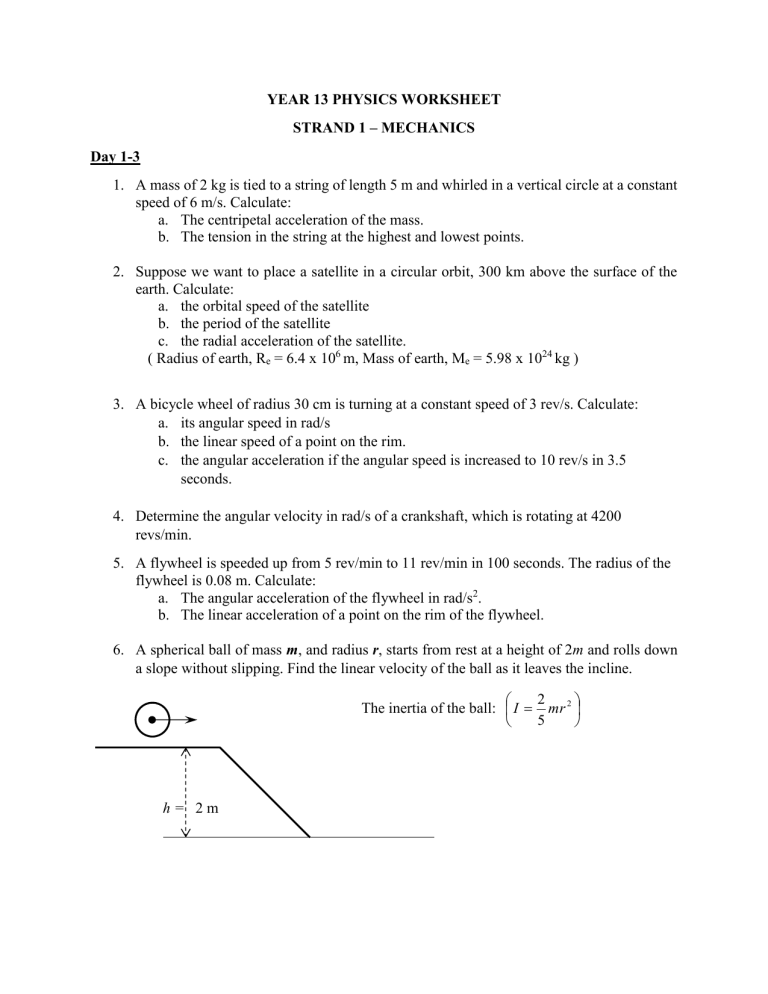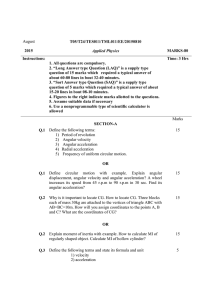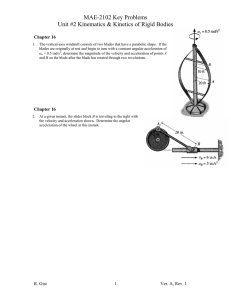
YEAR 13 PHYSICS WORKSHEET STRAND 1 – MECHANICS Day 1-3 1. A mass of 2 kg is tied to a string of length 5 m and whirled in a vertical circle at a constant speed of 6 m/s. Calculate: a. The centripetal acceleration of the mass. b. The tension in the string at the highest and lowest points. 2. Suppose we want to place a satellite in a circular orbit, 300 km above the surface of the earth. Calculate: a. the orbital speed of the satellite b. the period of the satellite c. the radial acceleration of the satellite. ( Radius of earth, Re = 6.4 x 106 m, Mass of earth, Me = 5.98 x 1024 kg ) 3. A bicycle wheel of radius 30 cm is turning at a constant speed of 3 rev/s. Calculate: a. its angular speed in rad/s b. the linear speed of a point on the rim. c. the angular acceleration if the angular speed is increased to 10 rev/s in 3.5 seconds. 4. Determine the angular velocity in rad/s of a crankshaft, which is rotating at 4200 revs/min. 5. A flywheel is speeded up from 5 rev/min to 11 rev/min in 100 seconds. The radius of the flywheel is 0.08 m. Calculate: a. The angular acceleration of the flywheel in rad/s2. b. The linear acceleration of a point on the rim of the flywheel. 6. A spherical ball of mass m, and radius r, starts from rest at a height of 2m and rolls down a slope without slipping. Find the linear velocity of the ball as it leaves the incline. 2 The inertia of the ball: I mr 2 5 h= 2m 7. A cylinder with a diameter of 16 cm and mass of 7.2 kg starts from rest and is accelerated uniformly by a force of 240 N applied to it tangentially. a. Calculate the rotational inertia of the hollow cylinder. ( I = MR2 ) b. What is the angular acceleration of the cylinder? 8. A man is pulling a crate of mass 50 kg ( weight = 500 N ) with a force of 200 N. The coefficient of kinetic friction between the floor and crate is 0.2. Calculate: a. the frictional force exerted by the floor. b. the acceleration of the box. 9. Two masses are connected by a light inextensible string over a frictionless pulley. The coefficient of friction between the 7 kg mass and the plane is 0.25. Calculate the acceleration of the system. 7 kg 12 kg 30o 10. A car is banking a curve inclined at 30o. If the friction between the tyre and the road is = 0.32 and the radius of the curve is 70 m , what is the maximum speed the car can turn without slipping? 11. A satellite of mass 500 kg is launched from a site on the earth’s equator into an orbit of 200 km above the surface of the earth. Assuming the satellite orbit is circular. Calculate: a. the speed of the satellite b. the orbital period of the satellite c. the minimum energy needed to place the satellite in orbit. 12. The mean radius of the earth’s orbit around the sun is 1.5 x 108 km and it takes 365.25 days to complete the one revolution. Calculate the mass of the sun. STRAND 2 – OSCILLATORY MOTION Day 4-5 1. In a SHM an object completes 10 vibrations in 2 seconds. Find the angular frequency of the SHM. 2. A 0.4 kg mass hangs from a spring with spring constant of 80 N/m. It is set in SHM with amplitude of 0.1m. Calculate the acceleration at its maximum displacement. 3. An object performs SHM according to the equation Find: a. the amplitude of the motion b. the angular frequency 4. A 4 kg mass is suspended by a spring, which is stretched 0.16 m when the mass is attached. The mass is then pulled down an additional 0.1 m and released. It starts performing SHM. Calculate: a. the spring constant, k b. the period T. c. the maximum speed of the mass 5. The piston in a car engine moves in approximate SHM with amplitude 40 mm and frequency of 120 Hz. Calculate: a. the maximum acceleration. b. the pistons speed at a displacement of 20 mm. 6. A 0.5 kg mass is connected to a spring with a constant of 20 N/m and undergoes SHM with amplitude of 3.0 cm. Calculate: a. the maximum velocity of the mass b. the velocity when the mass is at a displacement of 2.0 cm. 7. A 1.5 kg mass is oscillating at the end of a steel spring with an amplitude of 15 cm. The spring constant, k, is 600 N/m. Calculate: a. the angular frequency b. the maximum velocity of the oscillating mass c. the total energy of the oscillating mass. 8. A pendulum of length 1.2 m oscillates with amplitude of 0.2 m. a. What is the period of the pendulum? b. Find the velocity at the mid point of the swing. c. If the mass of the pendulum bob is doubled, calculate the new period. y = - 15 sin 0.5t (cm), 9. x = 6.5 cos 3t . Calculate: 4 the period, amplitude and phase constant of the motion. the displacement at t = 0s and t = 1s. the velocity and acceleration at t = 3 s. the maximum speed and acceleration The equation of a SHM is given as a. b. c. d. 10. A 3 kg mass is fastened to a light spring that passes over a pulley. The pulley is frictionless and its inertia can be neglected. The mass is released from rest when the spring is unstretched. The mass drops 10 cm before coming to rest. The mass then vibrates with an amplitude of 5 cm. a. Find the force constant of the spring. b. Find the period of vibration of spring. c. Calculate the velocity of the mass when it is 5 cm below the starting point. d. Write an equation for the vibration of the mass. 11. A spiral spring of natural length 400 mm is suspended vertically from a fixed point with its upper end fixed. A mass of 0.20 kg is suspended at rest from the lower end of the spring to increase its length to 460 mm. The mass is then pulled down a further distance of 40 mm and released from rest so it oscillates about the equilibrium. Calculate: a. the stiffness constant ( spring constant ) b. the frequency of the oscillation c. the maximum speed of the mass d. the maximum kinetic energy of the mass e. the maximum tension in the spring.



